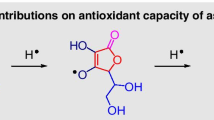Abstract
The interaction of superoxide radical anion (O2 •−) with active dicarbonyls (methylglyoxal, glyoxal, and malonic dialdehyde) was studied. It was demonstrated that glyoxal and methylglyoxal inhibited superoxide-dependent accumulation of formazan; however, malonic dialdehyde stimulated this process. The formation of O2 •− in these experiments occurred during the decomposition of the SOTS-1 azo initiator. On the other hand, all of the studied dicarbonyls in this system of O2 •− generation competed for superoxide with the TIR ON spin trap. These compounds also inhibited luminal-dependent chemiluminescence during the AIBN azo initiator-induced peroxidation of liposomes from the egg phosphatidylcholine. A mechanism for the antiradical and antioxidant effects of the studied dicarbonyls, assuming the production of free radical intermediates in their reactions with O2 •− or its protonated form, is proposed.
Similar content being viewed by others
Abbreviations
- SOTS-1:
-
bis(4-carboxybenzyl) hyponitrite
- TIR ON:
-
sodium 4,5-dihydroxybenzene-1,3-disulphonate
- AIBN:
-
azobisbutyronitrile
References
T. Ishii, S. Kumazawa, T. Sakurai, et al., Chem. Res. Toxicol. 19, 122 (2006).
C. G. Schalkwijk, Immun. Endocr. Metab. Agents Med. Chem. 7, 57 (2007).
P. J. Thornalley, Drug Metab. Drug Interact. 23, 125 (2008).
K. M. Desai and L. Wu, Drug. Metab. Drug. Interact. 23, 151 (2008).
P. B. L. Pun and M. P. Murphy, Int. J. Cell Biol. 2012, 1 (2012).
M. Katakura, M. Hashimoto, Y. Tanabe, and O. Shido, Med. Gas Res. 2, 1 (2012).
V. U. Chavan and R. R. Melinkeri, Natl. J. Commun. Med. 4, 294 (2013).
V. Z. Lankin, G. G. Konovalova, A. K. Tikhaze, et al., Mol. Cell. Biochem. 395, 241 (2014).
M.-S. Hsieh and W.-H. Chan, Int. J. Mol. Sci. 10, 1445 (2009).
K. B. Shumaev, S. A. Gubkina, E. M. Kumskova, et al., Biochemistry (Moscow) 74, 461 (2009).
J. F. Turrens, J. Physiol. 552, 335 (2003).
J. Massari, R. Tokikawa, L. Zanolli, et al., Chem. Res. Toxicol. 23, 1762 (2010).
Y. Matsumura, A. Iwasawa, T. Kobayashi, et al., J. Clin. Biochem. Nutr. 52, 128 (2013).
A. Szent-Gyorgyi, L. G. Egyud, and J. A. McLaughlin, Science 155, 539 (1967).
C. Beauchamp and I. Fridovich, Anal. Biochem. 44, 276 (1971).
M. I. Heller and P. L. Croot, Anal. Chim. Acta 667, 1 (2010).
C. L. Greenstock and R. W. Miller, Biochim. Biophys. Acta 396, 11 (1975).
O. V. Korkina and E. K. Ruuge, Biophysics (Moscow) 45 (4), 676 (2000).
H. U. Bergmeyer, K. Gawehn, and M. Grassl, in Methods of Enzymatic Analysis, 2nd ed., Ed. by H. U. Bergmeyer, (Academic Press, New York, 1974), Vol. 1, pp. 521–522.
L. J. Marnett, M. J. Bienkowski, M. Raban, and M. A. Tuttle, Anal. Biochem. 99, 458 (1979).
C. Achilli, S. Grandi, A. Ciana, et al., Chem. Papers 68, 662 (2014).
J. R. Baker, D. V. Zyzak, S. R. Thorpe, and J. W. Baynes, Clin. Chem. 40, 1950 (1994).
V. Z. Lankin, G. G. Konovalova, A. K. Tikhaze, et al., in Handbook of Lipoprotein Research (Nova Sci. Publ., New York, 2010), pp. 85–107.
W. M. Tolles and D. W. Moore, J. Chem. Phys. 46, 2102 (1967).
C. Thomson, J. Biol. Phys. 7, 39 (1979).
C. Mottley, R. E. Robinson, and R. P. Mason, Arch. Biochem. Biophys. 289, 153 (1991).
I. Hermans, J. F. Müller, T. L. Nguyen, et al., J. Phys. Chem. A 109, 4303 (2005).
Author information
Authors and Affiliations
Corresponding author
Additional information
Original Russian Text © K.B. Shumaev, V.Z. Lankin, G.G. Konovalova, A.K. Tikhaze, E.K. Ruuge, 2017, published in Biofizika, 2017, Vol. 62, No. 2, pp. 237–242.
Rights and permissions
About this article
Cite this article
Shumaev, K.B., Lankin, V.Z., Konovalova, G.G. et al. The interaction of superoxide radicals with active dicarbonyl compounds. BIOPHYSICS 62, 172–176 (2017). https://doi.org/10.1134/S0006350917020245
Received:
Published:
Issue Date:
DOI: https://doi.org/10.1134/S0006350917020245




